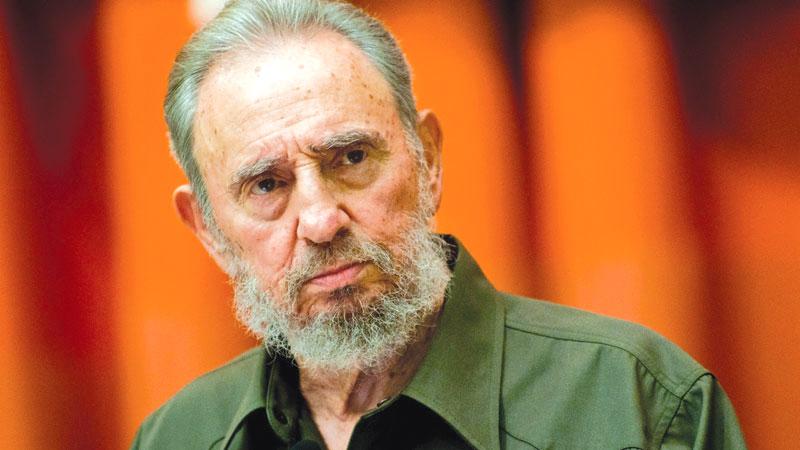
The convoy carrying the ashes of Cuba’s late communist leader Fidel Castro ends an island-wide journey today in the cradle of his revolution for a big ceremony before his burial.
The flag-draped cedar urn left Havana on Wednesday, passing roads lined with people chanting ‘I am Fidel!’ (Yo Soy Fidel) and making daily stops on the way to Santiago de Cuba in the eastern end of the country.
President Raul Castro, who took over when his brother fell ill in 2006, delivered a much-awaited speech during a massive tribute with foreign dignitaries on Saturday evening.
Capping a nine-day mourning period, the remains will be interred during a private ceremony today at the Santa Ifigenia cemetery, where 19th century independence hero Jose Marti is buried.
Fidel Castro’s death on November 25 at age 90 has fueled discussions about his divisive legacy and the direction that the country may take without the omnipresent leader who ruled for almost half a century.
Tearful supporters have cheered Fidel Castro for the free education and health care he spread in the island, while detractors call him a dictator.”
He has been the father of all Cubans and all the people in need in the world,” said Margarita Aguilera, the 54-year-old director of a state tobacco company who painted the words “farewell, comandante” on stone.
Enediel Rodriguez, 50, was helping to make preparations Friday in a public hall where people will be able to watch the arrival of the jeep with the ashes before they go out on the street.”He will rest in Santiago de Cuba because Marti is our national apostle and this was his idea, to rest here next to him,” Rodriguez said.
Bearded rebels
The government had already led a huge rally with two dozen foreign presidents in Havana on Tuesday, but Santiago holds a special place in Castro’s life.On July 26, 1953, the Castro brothers launched a failed attack on the Moncada military barracks in the city, some 900 kilometers (560 miles) east of Havana.
While the rebels were jailed, it put Castro on the map and he would eventually go into exile in Mexico.”Condemn me, it does not matter,” the trained lawyer had famously said at his trial.
“History will absolve me.”Three years after the Moncada defeat, the Castro brothers and their band of bearded rebels returned to Cuba aboard a ship named Granma. On Friday, Cuba marked 60 years since the yacht landed in a southeastern beach.
The rebels fled into the Sierra Maestra Mountains, launching a guerrilla war that would end in triumph against dictator Fulgencio Batista on January 1, 1959.
Following their victory, Castro celebrated by touring the island from Santiago to Havana in a march known as “La Caravana de la Libertad” (caravan of freedom).
His ashes are being taken on the reverse route under the same theme. It retraces the journey he made in 1959 after arguably the most audacious and inspiring revolution of the 20th century.
Historical moment
While hundreds of thousands of people have congregated along the road to bid farewell, the government has encouraged Cubans to sign a pledge to defend his revolution.The first major town on the route of the procession was Cienfuegos. Education manager María Elena Martínez says this is a historical moment, though she does not expect it to usher in big changes.
“I don’t think there is any Cuban who isn’t sad,” she says. “But even with Fidel gone, there is President Raúl Castro and then another revolutionary will take over from him.”
Castro’s ashes spent Wednesday night at the mausoleum of Ernesto “Che” Guevara in Santa Clara – a final farewell for two comrades-in-arms.
Another stop was at Sancti Spíritus, a city famed in revolutionary history for one of Castro’s most democratically idealistic speeches, given at 2am in the pouring rain during the original Caravan of Liberty on 6 January 1959 to a huge crowd eager to find out what the nascent revolution would mean for the country.
Roberto Garit, a community leader in Sancti Spíritus, is veteran of battles in Africa, where thousands of Cuban soldiers died fighting colonial and white minority regimes. Castro, he says, is like a father and a brother to him. “The greatest leader, an inspiration to the world.” As the official convoy approaches, he is in an emotional mood. “Listen to the silence,” he says. “I can hear my own heart beating.”
As the ashes reach his position, he waves a flag and yells Viva Fidel! (Long live Fidel!). Then dozens of his comrades – some standing to attention and saluting –echo back: Viva Fidel.
- NDTV, Guardian
